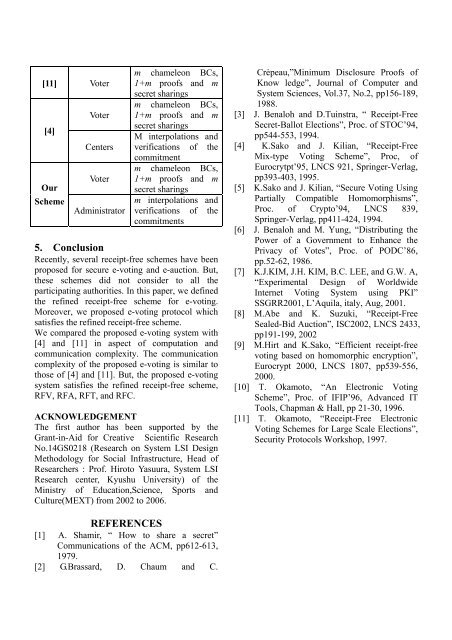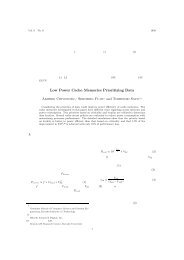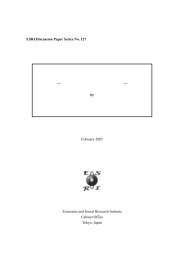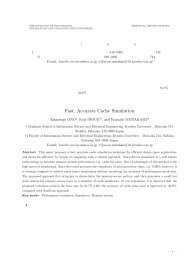1. Introduction ELECTRONIC VOTING ... - System LSI Lab.
1. Introduction ELECTRONIC VOTING ... - System LSI Lab.
1. Introduction ELECTRONIC VOTING ... - System LSI Lab.
Create successful ePaper yourself
Turn your PDF publications into a flip-book with our unique Google optimized e-Paper software.
[11] Voter<br />
[4]<br />
Our<br />
Scheme<br />
Voter<br />
Centers<br />
Voter<br />
Administrator<br />
m chameleon BCs,<br />
1+m proofs and m<br />
secret sharings<br />
m chameleon BCs,<br />
1+m proofs and m<br />
secret sharings<br />
M interpolations and<br />
verifications of the<br />
commitment<br />
m chameleon BCs,<br />
1+m proofs and m<br />
secret sharings<br />
m interpolations and<br />
verifications of the<br />
commitments<br />
5. Conclusion<br />
Recently, several receipt-free schemes have been<br />
proposed for secure e-voting and e-auction. But,<br />
these schemes did not consider to all the<br />
participating authorities. In this paper, we defined<br />
the refined receipt-free scheme for e-voting.<br />
Moreover, we proposed e-voting protocol which<br />
satisfies the refined receipt-free scheme.<br />
We compared the proposed e-voting system with<br />
[4] and [11] in aspect of computation and<br />
communication complexity. The communication<br />
complexity of the proposed e-voting is similar to<br />
those of [4] and [11]. But, the proposed e-voting<br />
system satisfies the refined receipt-free scheme,<br />
RFV, RFA, RFT, and RFC.<br />
ACKNOWLEDGEMENT<br />
The first author has been supported by the<br />
Grant-in-Aid for CreativeScientific Research<br />
No.14GS0218 (Research on <strong>System</strong> <strong>LSI</strong> Design<br />
Methodology for Social Infrastructure, Head of<br />
Researchers : Prof. Hiroto Yasuura, <strong>System</strong> <strong>LSI</strong><br />
Research center, Kyushu University) of the<br />
Ministry of Education,Science, Sports and<br />
Culture(MEXT) from 2002 to 2006.<br />
Crėpeau,”Minimum Disclosure Proofs of<br />
Know ledge”, Journal of Computer and<br />
<strong>System</strong> Sciences, Vol.37, No.2, pp156-189,<br />
1988.<br />
[3] J. Benaloh and D.Tuinstra, “ Receipt-Free<br />
Secret-Ballot Elections”, Proc. of STOC’94,<br />
pp544-553, 1994.<br />
[4] K.Sako and J. Kilian, “Receipt-Free<br />
Mix-type Voting Scheme”, Proc, of<br />
Eurocrytpt’95, LNCS 921, Springer-Verlag,<br />
pp393-403, 1995.<br />
[5] K.Sako and J. Kilian, “Secure Voting Using<br />
Partially Compatible Homomorphisms”,<br />
Proc. of Crypto’94, LNCS 839,<br />
Springer-Verlag, pp411-424, 1994.<br />
[6] J. Benaloh and M. Yung, “Distributing the<br />
Power of a Government to Enhance the<br />
Privacy of Votes”, Proc. of PODC’86,<br />
pp.52-62, 1986.<br />
[7] K.J.KIM, J.H. KIM, B.C. LEE, and G.W. A,<br />
“Experimental Design of Worldwide<br />
Internet Voting <strong>System</strong> using PKI”<br />
SSGRR2001, L’Aquila, italy, Aug, 200<strong>1.</strong><br />
[8] M.Abe and K. Suzuki, “Receipt-Free<br />
Sealed-Bid Auction”, ISC2002, LNCS 2433,<br />
pp191-199, 2002<br />
[9] M.Hirt and K.Sako, “Efficient receipt-free<br />
voting based on homomorphic encryption”,<br />
Eurocrypt 2000, LNCS 1807, pp539-556,<br />
2000.<br />
[10] T. Okamoto, “An Electronic Voting<br />
Scheme”, Proc. of IFIP’96, Advanced IT<br />
Tools, Chapman & Hall, pp 21-30, 1996.<br />
[11] T. Okamoto, “Receipt-Free Electronic<br />
Voting Schemes for Large Scale Elections”,<br />
Security Protocols Workshop, 1997.<br />
REFERENCES<br />
[1] A. Shamir, “ How to share a secret”<br />
Communications of the ACM, pp612-613,<br />
1979.<br />
[2] G.Brassard, D. Chaum and C.















